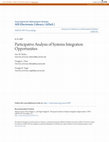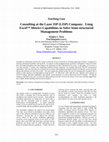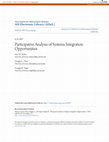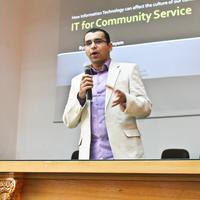Papers by Dr. Douglas L. Dean
JMIR serious games, Dec 14, 2021

BACKGROUND Organizations of all types require the use of teams. Poor team member engagement costs... more BACKGROUND Organizations of all types require the use of teams. Poor team member engagement costs billions of US dollars annually. OBJECTIVE Explains how team building can be accomplished with team video gaming (TVG) based on a team cohesion model enhanced by team flow theory. METHODS In this controlled experiment, teams were randomly assigned to a TVG treatment or a control treatment. Team performance was measured on basic tasks both pre- and post-treatment. Then teams who received the TVG treatment competed against other teams by playing the Halo™ or Rock Band™ video game for 45 minutes. RESULTS On the posttest task, teams from the TVG treatments were significantly more productive than teams that did not experience TVG. Our model explained performance improvement about twice as well as prior related research. CONCLUSIONS The focused immersion caused by TVG increased team performance while the enjoyment component of flow decreased team performance on the posttest. Both flow and team cohesion contributed to team performance, with flow contributing more than cohesion. TVG did not increase team cohesion so TVG effects are independent of cohesion. TVG is a valid practical method for developing and improving newly formed teams CLINICALTRIAL n/a

The Journal of information and systems in education, Nov 1, 2003
Introductory Information System (IS) courses commonly focus too heavily on teaching application f... more Introductory Information System (IS) courses commonly focus too heavily on teaching application features, as opposed to teaching unstructured problem-solving skills. In response to this pedagogical gap, professors at Brigham Young University have developed integrated cases that improve the instruction for their introductory IS course. In this paper, we overview a case that provides a realistic and compelling problem-solving experience for teaching Microsoft Excel™ measurement capabilities. This case describes the customer service issues and installation problems faced by an Internet service provider, along with pertinent cost and service data. The case requires the student to play the role of a management consultant who is asked to make business recommendations using Excel™. To effectively work with this case, students need exposure to Excel™ lookups, date/time capabilities, and countif / sumif functions, as well as other basic Excel™ features. To help the instructor implement this case, we have provided teaching notes that overview the history of the case, teaching suggestions, and a highly detailed grading and discussion template.
Social Science Research Network, 1997

International Conference on Information Systems, 2016
Organizational tasks are complex and time-sensitive, requiring group effort to achieve goals unde... more Organizational tasks are complex and time-sensitive, requiring group effort to achieve goals under pressure. To improve group performance, organizations often invest in a services designed to strengthen teams (e.g., ropes courses). However, such activities are time-and resource-expensive and have demonstrated mixed results. To proffer a more practical (shorter and less expensive) alternative, we explore the potential of video gaming as a team building activity. To this end, we employed a multi-experiment study in which we administered competitive and cooperative video games to newly formed work teams. To theoretically explain the effects of video gaming on group performance, we adapt the theoretical construct to flow to the group level. Our results reveal that all forms of video gaming had a positive effect on group performance. However, competitive versus cooperative gaming have different effects on the sub-constructs of group flow. Therefore, optimal results are obtained with cooperative-competitive video games.

In an effort to increase information sharing while simultaneously decreasing costs, many organiza... more In an effort to increase information sharing while simultaneously decreasing costs, many organizations are moving to integrated data and systems. However, researchers caution that the costs and benefits of integration must be carefully evaluated. This paper presents a participative integration analysis methodology for determining not only what "can" be integrated, but also what "should" be integrated. Results of the initial case study show that a small group can effectively decide what "should" be integrated and develop a proposed integration strategy. The results also highlighted that participants intuitively used business scenarios to identify integration opportunities and analyze the business impacts of integration. Therefore, the participative integration analysis methodology was updated to incorporate scenarios as the central evaluative construct. This methodology will result in recommendations for integrated systems and business processes.

Business models aid analysis and become the blueprints for improved business practices and inform... more Business models aid analysis and become the blueprints for improved business practices and information systems. The IDEF0 definition method is one method commonly used to develop business activity models. IDEF0 models are developed to reflect business processes. An IDEF0 model consists of an activity hierarchy and the attending inputs, controls, outputs, and mechanisms that border and link activities. Model production is costly, and model accuracy is important. It is critical to involve knowledgeable participants and stakeholders during model development and analysis. This results in valid models and increases the likelihood that changes based on the models will be accepted. Traditional IDEF0 modeling approaches, however, are supported by a single-user IDEF0 tool. The fact that all model information must be channeled through a scribe significantly limits model development speed and restricts productive, direct involvement to a few individuals. This dissertation explores electronic meeting systems (EMS) as a means of increasing the number of people who can productively participate during model development. General EMS includes networked computer workstations for all participants, a video projection system, and group support software that enables participants to contribute ideas, analyze options, vote on alternatives, and so forth. This research chronicles the evolutionary development and evaluation of a group-enabled IDEF0 modeling tool for use with general EMS for support of group modeling efforts. EMS-supported modeling efforts are compared with traditionally-supported modeling efforts. EMS support overcomes some bottlenecks inherent in the traditional approach, allowing significantly more individuals to productively participate during model development. Although previous research had demonstrated that EMS-IDEF0 tools can be used by large groups to rapidly develop some model content, the corresponding facilitation methods had produced incomplete and ambiguous models. Part of this research involved the development and evaluation of three modeling approaches for use with EMS. These produced varying levels of productivity and model quality. The most successful approach, the top-down integrated (TDI) approach, overcomes significant problems inherent in the other approaches. This approach allows analysts to work with business personnel to produce complete models approximately twice as fast as the traditional modeling approach.
Based on the analysis of representative evaluation methods, through certain financial indicators,... more Based on the analysis of representative evaluation methods, through certain financial indicators, using the financial data of listed companies of China, we use the Logistic regression method to build the credit evaluation model.We make empirical analysis from 126 samples, 19 financial indiacrots and 7 factors, the results match the results of credit rating agencies and the actual situation of the company.

J. Inf. Syst. Educ., 2003
Introductory Information System (IS) courses commonly focus too heavily on teaching application f... more Introductory Information System (IS) courses commonly focus too heavily on teaching application features, as opposed to teaching unstructured problem-solving skills. In response to this pedagogical gap, professors at Brigham Young University have developed integrated cases that improve the instruction for their introductory IS course. In this paper, we overview a case that provides a realistic and compelling problem-solving experience for teaching Microsoft Excel™ measurement capabilities. This case describes the customer service issues and installation problems faced by an Internet service provider, along with pertinent cost and service data. The case requires the student to play the role of a management consultant who is asked to make business recommendations using Excel™. To effectively work with this case, students need exposure to Excel™ lookups, date/time capabilities, and countif / sumif functions, as well as other basic Excel™ features. To help the instructor implement this case, we have provided teaching notes that overview the history of the case, teaching suggestions, and a highly detailed grading and discussion template.

Organizational tasks are complex and time-sensitive, requiring group effort to achieve goals unde... more Organizational tasks are complex and time-sensitive, requiring group effort to achieve goals under pressure. To improve group performance, organizations often invest in a services designed to strengthen teams (e.g., ropes courses). However, such activities are time-and resource-expensive and have demonstrated mixed results. To proffer a more practical (shorter and less expensive) alternative, we explore the potential of video gaming as a team building activity. To this end, we employed a multi-experiment study in which we administered competitive and cooperative video games to newly formed work teams. To theoretically explain the effects of video gaming on group performance, we adapt the theoretical construct to flow to the group level. Our results reveal that all forms of video gaming had a positive effect on group performance. However, competitive versus cooperative gaming have different effects on the sub-constructs of group flow. Therefore, optimal results are obtained with cooperative-competitive video games.

Journal of the Association for Information Systems, 2009
Usability flaws found in the later stages of the software development process can be extremely co... more Usability flaws found in the later stages of the software development process can be extremely costly to resolve. Accordingly, usability evaluation (UE) is an important, albeit usually expensive, part of development. We report on how the inexpensive UE method of heuristic evaluation (HE) can benefit from collaborative software (CSW), implicit coordination, and principles from collaboration engineering. In our study, 439 novice participants were trained in HE methods and then performed HE. Our results show that traditional nominal HE groups can experience implicit coordination through the collaborative software features of group memory and group awareness. One of the key results is that CSW groups had less duplication of effort than traditional nominal groups; these differences were magnified as group size increased from three to six members. Furthermore, because they coordinated less, traditional nominal groups performed more work in the overall process of HE. We attribute the reduction in duplication for CSW-supported groups to the implicit coordination available to them; CSW-supported groups could see violations input by other group members, but could not directly discuss the violations. These findings not only show the power of implicit coordination in groups, but should dramatically change how HE is conducted. These results may also extend to other evaluation tasks, such as software inspection and usability assessment tasks.

Management Science, 1997
We examine decision analysis’ central “decomposition principle” in the context of work-time estim... more We examine decision analysis’ central “decomposition principle” in the context of work-time estimates of software writers. Two experiments examined the abilities of advanced programming students to estimate how long they would take to complete specific software projects. They estimated their own work times both for entire projects and for their constituent subtasks. Estimates showed varying degrees of overoptimism and overpessimism but all were much too tight, with almost half of actual outcomes falling in the 1% tails of estimated distributions. This overtightness was unaffected by task decomposition, question wording, question order, or training in estimation. It was, however, significantly reduced by a procedure aimed at inducing generous upper and lower plausible limits. An underlying model of incomplete search is used to connect these findings to existing themes in cognition and judgment research, as well as to practical application. The findings suggest that the best level of ...
Electronic Commerce Research, 2007

In an effort to increase information sharing while simultaneously decreasing costs, many organiza... more In an effort to increase information sharing while simultaneously decreasing costs, many organizations are moving to integrated data and systems. However, researchers caution that the costs and benefits of integration must be carefully evaluated. This paper presents a participative integration analysis methodology for determining not only what "can" be integrated, but also what "should" be integrated. Results of the initial case study show that a small group can effectively decide what "should" be integrated and develop a proposed integration strategy. The results also highlighted that participants intuitively used business scenarios to identify integration opportunities and analyze the business impacts of integration. Therefore, the participative integration analysis methodology was updated to incorporate scenarios as the central evaluative construct. This methodology will result in recommendations for integrated systems and business processes.
i.a, U on user interviews or group meetings as the primary mechanisms for involving users. Howeve... more i.a, U on user interviews or group meetings as the primary mechanisms for involving users. However, these requirements for a special-purpose GSS scenario tool. The next section provides additional background and











Uploads
Papers by Dr. Douglas L. Dean